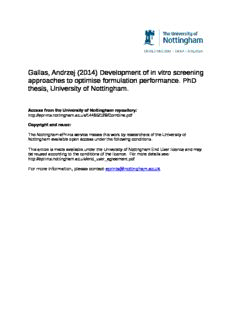
Gallas, Andrzej PDF
Preview Gallas, Andrzej
DEVELOPMENT OF IN VITRO SCREENING APPROACHES TO OPTIMISE FORMULATION PERFORMANCE. ANDRZEJ GALLAS, mgr farm. ThesissubmittedtotheUniversityofNottingham forthedegreeofDoctorofPhilosophy. September2013 Abstract. The pharmaceuticalindustry has been criticised foralack of innovation associated with the drug discovery and development process, for example when compared with the computer ormusicindustries.Infact,bringinganewmedicinetothemarketrequires,onaverage,the screeningofupto 10 000molecules, anexpense inthe range of$500million-$2 billionand roughly 10-15 years ofresearch.Suchasituationnot only hasadirect impact onthe health and life expectancy of every single human being on the planet, but also indicates that alternativestrategiesfordrugdevelopmentshouldbeinvestigated. In this thesis, studies of direct formulation-membrane interactions, both in a high throughput (HT) manner and at a nanometre scale, were initially identified asan important approach that could offer advantages for in vitro-in vivo correlations of in-man drug behaviours. Subsequently, supported lipid bilayers (SLBs) of physiologically-relevant lipid compositions were indicated as experimental models of preference for pre-clinical drug development. For that reason, the characterisation and assessment of physicochemical and behavioural properties of the model SLBs at a nanometre scale, as well as development of anSLBmicroarrayforHTapplicationswerethefocusofthisresearch.Here,theoptimisation and characterisation of model lipid films was performed using atomic force microscopy (AFM), time-of-flight secondary ion mass spectrometry (ToF-SIMS) and X-ray photoelectron spectroscopy (XPS). Additionally, the AFM-investigated assessment of the interactions between model SLBs and formulation components (e.g. Pluronics®, siRNA, DNA polyplexes) enabled both the correlation of in vitro observations with literature-reported in vivo performances of the components of interest and the development of hypotheses with regards a number of phenomena in biology. Furthermore, the development of a SLB microarrayprototypesuitableforHTapplicationsisreported. Directly, this research improves: the understanding of SLB behaviours and experimental investigation at a nanometre scale of the mechanisms of interactions between membranes and: Pluronics®, nucleic acids and their complexes, as well as the technology of SLB microarray development. Indirectly, this research contributes towards the progress in a number of research areas within pharmaceutical sciences, potentially resulting in new scientificdisciplines,suchasimmunolipidomicsornanopharmacology. 2 Acknowledgements. IwouldliketothankEPSRC,AstraZenecaandUniversityofNottinghamforfunding. I would like to thank my supervisors: Dr Stephanie Allen, Prof. Cameron Alexander, Prof. Morgan Alexander, Prof. Martyn Davies and Dr Sanyogitta Puri for help and guidance throughouttheproject. IwouldliketothankProf.XinyongChen,DrDavidScurr,MrsEmily Smith,DrAndrew Hook, Dr Adam Celiz, Dr Francisco Fernandez-Trillo and other members of the Laboratory of Biophysics and Surface Analysis and the Drug Delivery groups for advice and hands-on help inlaboratory. Mamo, Tato, Haniu, Leszku, babciu Zosiu i Mirciu, dziadku Stasiu i Jurku – serdecznie dziękuję za wsparcie, pomoc i wszystko co umożliwiło mi zrobienie tego doktoratu. IwouldalsoliketothankMrsChristineGrainger-Boultby,MrPaulCooling,MrsJuliaCrouch, DrChristinaGrindonandDrClaudiaMatzfortechnicalsupportduringmyPhD. IwouldparticularlyliketothankSarah,Gökçen,Vanessa,Marek,Alim,SelinaandBeppefor friendshipandsupportthroughoutmytimeinNottingham. Finally, I would like thank my assessors: Prof. Clive Roberts and Dr Patrick Gunning for feedbackandtimetheyspentonimprovingthisthesis. AndrzejGallas. 3 ListofContents. TitlePage………………………………………………………………………………………………………………………………………………………………1 Abstract…………………………………….…………………………………………………………………………………………………………………….……2 Acknowledgements…………………….………………………………………..………………………………………………………………………………3 ListofContents…………………………………………………………..…………………………………………………………………………………………4 ListofFigures…………………………………………………………………………………………..……………………………………………………………7 ListofTables……..………………………………………………………………………………………………………………………………………………..10 Preface………………………………………………………………………………………………………………………………………………………………..11 1 Chapter1:IntroductionandAims. Supportedlipidbilayersasmodelsforpre-clinicaldevelopmentofnewdrugs…………………..…12 1.1. Abstract………………………………………………………………………………………………………………………..…………………………12 1.2. Introduction……………………………………………………………………………………………………….……………………………………13 1.3. Theimportanceofmembraneinteractionsinpharmaceuticalsciences…………………………………….……………14 1.4. Modelsformembraneinteractions:developmentandtypes.…………………………………………………………………17 1.5. SLBsasamodelformembraneinteractions……………………………………………………………………………………………21 1.6. CurrentlimitationsassociatedwithSLBs…………………………………………………………………………………………………26 1.7. Conclusionsandfutureprospects.……………………………………………………..……………………………………………………27 1.8. References………………………………………………………………………………………………………………………………………………30 2 Chapter2:MaterialsandMethods. 2.1. Materials………………………………………………………………………………………………………………………………………………33 2.2. Methods………………………………………………………………………………………………………………………………………………36 2.2.1. Preparationofsupportedlipidbilayers……………………………………………………………………………………………..…36 2.2.1.1. Calculationoflipidamountsforliposomepreparation……………………………………………………………………………….…36 2.2.1.2. Bilayerself-spreadingtechnique(BSST).…………………………………………………………………………………………………..…36 2.2.1.3. Vesicledepositiontechnique(VDT).……………………………………………………………………………………..……………………36 2.2.2. AtomicForceMicroscopy(AFM)……………………………………………………………………………………………………….…37 2.2.2.1. Background……………………………………………………………………………………………………………………………………………37 2.2.2.2. Experimental……………………………………………………………………………………………………………………………………….…38 2.2.2.2.1.BasicSLBimaging(chapter3and4).………………………………………………………………………………………………………..…38 2.2.2.2.2.SLBinteractionstudies(chapter5)………………………………………………………………………………………………………………38 2.2.2.2.3.SLBairstabilitystudies(chapter1and6)……………………………………………………………………………………………………39 2.2.2.2.4.SLBmicroarrayimaging(chapter6)…………………………………………………………………………………………………..………39 2.2.2.2.5.ImagingofPolyphosphonium-DNApolyplexes(chapter5)……………………………………………………………………………39 2.2.2.2.6.PreparationandimagingofFluidArray®-likesurfaces(chapter6)………………………………………………………………..…40 2.2.2.2.7.AFMdataanalysis……………………………………………………………………………………………………………………………………40 2.2.2.2.7.1. EvaluationofSLBthickness…………………………………………………………………………………………………….…40 2.2.2.2.7.2. QuantificationofSLBcoverage………………………………………………………………………………………………..…41 2.2.2.2.7.3. Evaluationofparticlesize…………………………………………………………………………………………………….……41 2.2.3. Time-of-FlightSecondaryIonMassSpectrometry(ToF-SIMS)………………………………………………………………41 2.2.3.1. Background.……………………………………………………………………………………………………………………………………………41 2.2.3.2. Experimental…………………………………………………………………………………………………………………………………….……42 2.2.3.3. ToF-SIMS:dataanalysis……………………………………………………………………………………………………………………………42 2.2.4. X-rayPhotoelectronSpectroscopy(XPS)………………………………………………………………………………………………43 2.2.4.1. Background……………………………………………………………………………………………………………………………………………43 2.2.4.2. Experimental…………………………………………………………………………………………………………………………………….……44 2.2.4.2.1. XPS:samplepreparation……………………………………………………………………………………………………………………..……44 2.2.4.2.2. XPS:dataanalysis……………………………………………………………………………………………………………………………………45 2.2.4.2.2.1. Calculationofthetheoreticallipidcontentandratiobetween:-N+(CH),=N+(H)and–NH-nitrogen 3 2 groupsforlipidfilmsamplesanalysedwithXPSintheN1sregion……………………………………………………46 2.2.4.2.2.2. CalculationoftheoreticalintensityoftheP2ppeakforlipidfilmsamplesanalysedwithXPS intheP2pregion..…………………………………………………………………………………………………………………..47 2.2.5. DynamicLightScattering(DLS)……….……………………………………………………………………………………………………47 2.2.5.1. Background……………………………………………………………………………………………………………………………………………47 4 ListofContents. 2.2.5.2. Experimental……………………………………………………………………………………………………………………………………….…48 2.2.5.2.1. DLS:samplepreparation………………………………………………………………………………………………………………………..…48 2.2.5.2.2. DLS:dataanalysis……………………………………………………………………………………………………………………………………48 2.2.6. Piezoelectricinkjetprintheadtechnology……………………………………………………………………………………………48 2.2.6.1. Background……………………………………………………………………………………………………………………………………………48 2.2.6.2. Experimental……………………………………………………………………………………………………………………………………….…49 2.2.7. PreparationofPluronic®solutions(chapter4and6)……………………………………………………………………………50 2.2.8. PreparationofDNAcomplexes(chapter5)….………………………………………………………………………………………50 2.2.9. Preparationoftextandfigures………………………………………………………………………………………………………….…51 2.3. References……………………………………………………………………………………………………………………………………………51 3 Chapter3:FabricationandCharacterisationofModelSLBs. Advancedsurfaceanalysistechniquesforthedevelopmentofasupportedlipidbilayer model………….……………………………………………………………………………………………………………………………………………………53 3.1 Abstract……………………………………………………………………………………………………………………………………………….………53 3.2 Introduction…………………………………………………………………………………………………………………………………………………54 3.3 MaterialsandMethods……………………………………………………………………………………………………………………………..…54 3.4 ResultsandDiscussion…………………………………………………………………………………………………………………………………55 3.4.1 StudyingSLBmorphologyandcomposition…………………………………………………………………………………………………55 3.4.1.1 AFM:optimisationofmodelSLBfabricationprotocols……………………………………………………………………………….…55 3.4.1.2 ToF-SIMS:qualitativeandsemi-quantitativeevaluationofmodellipidfilms………………………………………………….…57 3.4.1.3 XPS:quantitativeevaluationofmodellipidfilms……………………………………………………………………………………….…62 3.4.2 AFM:studyingSLBbehaviour.……………………………………………………………………………………………………………….…71 3.5 Conclusion……………………………………………………………………………………………………………………………………………………79 3.6 References………………………………………………………………………………………………………………………………………………..…79 4 Chapter4:ModelSLBs-ExcipientInteractionStudies. Supportedlipidbilayerstoaidunderstandingofpharmaceutical excipientperformancesinvitro…………………………………………………………………………………………………………….…81 4.1 Abstract……………………………………………………………………………………………………………………………………………………….81 4.2 Introduction…………………………………………………………………………………………………………………………………………………82 4.3 MaterialsandMethods……………………………………………………………………………………………………………………………..…82 4.4 ResultsandDiscussion…………………………………………………………………………………………………………………………………83 4.5 Conclusion……………………………………………………………………………………………………………………………………………………93 4.6 References…………………………………………………………………………………………………………………………………………………..93 5 Chapter5:ModelSLBs-NucleicAcidFormulationInteractionStudies. Supportedlipidbilayers:stop-changeinnucleicacidpharmacology………………………………………….94 5.1 Abstract……………………………………………………………………………………………………………………………………………………….94 5.2 Introduction…………………………………………………………………………………………………………………………………………………95 5.3 MaterialsandMethods………………………………………………………………………………………………………………………………..96 5.4 ResultsandDiscussion…………………………………………………………………………………………………………………………………96 5.4.1 Nucleicacid-SLBinteractions…………………………………………………………………………………………………………………….96 5.4.2 DNApolyplex-SLBinteractions…………………………………………………………………………………………………………………106 5.5 Conclusion…………………………………………………………………………………………………………………………………………………111 5.6 References…………………………………………………………………………………………………………………………………………………112 6 Chapter6:DevelopmentofSLBMicroarrayforNano-HTSApplications. Developmentofsupportedlipidbilayermicroarrayfor highthroughputscreeningapplicationsatnanoscale……………………………………………………………………114 6.1 Abstract……………………………………………………………………………………………………………………………………………………..114 6.2 Introduction……………………………………………………………………………………………………………………………………………….115 5 ListofContents. 6.3 MaterialsandMethods………………………………………………………………………………………………………………………………115 6.4 ResultsandDiscussion……………………………………………………………………………………………………………………….………116 6.4.1 OptimisationofSLBfabricationmethodonmicroscopeslide-sizedmicasheets………………………………………………116 6.4.2 AFMstudiesofdry,modelSLBsinhighhumidityenvironments……………………………………………………………………119 6.4.3 OptimisationofthepiezoelectricinkjetprintingmethodologyforSLBmicroarraydevelopment…………………….…122 6.4.4 OptimisationoftheToF-SIMSchemicalimagingoftheSLBmicroarrays…………………………………………………………126 6.5 Conclusion…………………………………………………………………………………………………………………………………………………131 6.6 References…………………………………………………………………………………………………………………………………………………132 Chapter7:ConcludingRemarksandFutureProspects……………….………………………………………………...133 References…………………………………………………………………………………………………………………………………………………….136 AppendixI:AnalysisofAFMImages………………………………………………………………………………………………….....137 AppendixII:SupportingInformationonAFMStudies.………………………………………………………..……….....145 AppendixIII:MolecularIonAssignmentsforToF-SIMSSpectraofSingleLipids……..……………....154 AppendixIV:ChemistryandFormulationsforsiRNAtherapeutics…………………………………………......165 6 ListofFigures. 1. Chapter1:IntroductionandAims. 1.1. Thegraphicalsummaryofthefactorsinvolvedinthedevelopmentofthesupportedlipidbilayer (SLB)-basedmodelforstudyingformulation-membraneinteractions..……………………………………………………12 1.2. Illustrationdepictingtheimportanceofinteractionsbetween drugs(orformulations)andmembranes(orlipids)inpharmaceuticalsciences………………………………………15 1.3. Graphicalsummaryofthefactorsinvolvedinthedevelopment oftheParallelArtificialMembranePermeabilityAssay(PAMPA)……..……………………………………………………..17 1.4. StrategiesprovidingairstabilityforSLBs…………………………………………………………….…………………………………..27 2. Chapter2:MaterialsandMethods. 2.1. Thechemicalstructuresoflipids,PEO-PPO-PEO(Pluronic)tri-blockco-polymers and19bpDNAstrand………………………………………………………………………………………………………………………………35 2.2. TheschematicofAFMoperationprinciple…………………………………….………………………………………………………..38 2.3. TheschematicofToF-SIMSoperationprinciple…………………………….………………………………………………………..42 2.4. TheschematicofXPSoperationprinciple………………………………………………………………………………………………..44 2.5. TheschematicofDLSoperationprinciple………………………………………………………………………………………………..48 2.6. Theschematicofpiezoelectricinkjetprintheadtechnologyoperationprinciple…….………………………………49 3. Chapter3:FabricationandCharacterisationofModelSLBs. 3.1. Graphicindicatingthenatureofstudiesdiscussedinchapter3………………….…………………………………………..53 3.2. AFMimagesofBSST-fabricatedmodelSLBsandVDT-fabricatedmodellipidfilms……………….…………………56 3.3. ToF-SIMSspectraformicaandbothmodellipidfilmsamples inthe0–300umassregions……………………………………………………………………………………………..…………………..57 3.4. TheToF-SIMSchemicalimagespresentingthespatialdistributions ofsinglelipid-representativepeakswithinthemodellipidfilmsamples…………….…………………………………..60 3.5. Graphspresentingthesemi-quantitativeevaluationof singlelipid-representativepeakintensitieswithintheToF-SIMSspectra ofthemodellipidfilmsinbothpositiveandnegativemodes…………………………..……………………………………..61 3.6. Wide-scanXPSspectraindicatingtheelementalcompositions ofthesolidsupport(MICA)andtwomodellipidfilm(BSST,VDT)samples……………………………………………..62 3.7. Thegraphandequationdepictingthecalculationsofthelipidfilmcoverage forbothmodellipidfilmsamplespreparedusingvesicledeposition(VDT) andbilayerself-spreading(BSST)techniques…………………………………………………………………………………………..64 3.8. XPSspectraintheN1sregionindicatingthepeaksassociatedwiththepresence ofnitrogenonthesolidsupport(MICA),egg-phosphatidylcholine(EPC),sphingomyelin(SPM), cholesterol(CHOL),dioleoylphosphatidylethanolamine(DOPE), dioleoylphosphatidylserine(DOPS)andtwomodellipidfilm(BSST,VDT)samples………..……………………….66 3.9. ThegraphindicatingtheXPSspectraintheN1sregionformica, singlelipidandmodellipidfilmsamples…………………………………………………………….…………………………………..67 3.10. XPSspectraintheP2pregionindicatingthepeaksassociated withthepresenceofphosphorousonthesolidsupport(MICA),egg-phosphatidylcholine(EPC), sphingomyelin(SPM),cholesterol(CHOL),dioleoylphosphatidylethanolamine(DOPE), dioleoylphosphatidylserine(DOPS)andtwomodellipidfilm(BSST,VDT)samples…………………………………69 3.11. AFMimagespresentingtheinstancesofphaseseparationoccurrencewithinthemodelSLBs…….…………72 3.12. Thechemicalstructureofcholesterol(CHOL)……………………………………………….………………………….……………..73 3.13. Thechemicalstructuresofionicandnon-ionicmesomersofsphingomyelin(SPM)……..…………………………74 3.14. Illustrationofthe‘sphingomyelin(SPM)trap’hypothesis……………………………………………..………………………..75 3.15. Thechemicalandthree-dimensionalstructuresofDNA-deoxyribonucleicacid andRNA-ribonucleicacidmolecules……………………………………………………………………………………………………..77 4. Chapter4:ModelSLB-ExcipientInteractionStudies. 4.1. Graphicalabstractindicatingtheexperimentalfocusofchapter4………………..………………………………………..81 4.2. AFMimagespresentingstepsoftheinteractionsbetweenmodelSLBs ofdifferentbilayerqualitiesandPluronic®L-62monitoredovertime………….…………………………………………84 7 ListofFigures. 4.3. AFMimagespresentingstepsofinteractionsbetweenmodelSLBs ofdifferentbilayerqualitiesandPluronic®L-64monitoredovertime….…………………………………………………85 4.4. AFMimagespresentingstepsofinteractionsbetweenmodelSLBs ofdifferentbilayerqualitiesandPluronic®F-68monitoredovertime…….………………………………………………86 4.5. Schematicillustrationoftwobasicporetypesinalipidbilayer:hydrophilic andhydrophobic……………….87 4.6. Thegraphpresentingthechangesofthecoverageforpatch-like,modelSLBsovertime, afterexposureto0.001%(w/v)Pluronics:L-62,L-64andF-68inPBS……..……………………………………………88 4.7. Thegraphpresentingchangesofthecoverageofporous,modelSLBsovertime, afterexposureto0.0001%(w/v)Pluronics®:L-62,L-64andF-68inPBS…….……………………………………………90 4.8. Schematicillustrationofpossibleinteractionmechanismbetween phaseseparatedSLBsandPluronics®ofdifferentpolyethyleneoxideblockcontent………………………………92 5. Chapter5:ModelSLB-NucleicAcidFormulationInteractionStudies. 5.1. Graphicalabstractdepictingthespontaneousformationof DNA/sphingomyelin/cholesterol(DNA/SPM/CHOL)lipoplexes………………………………………………………………..94 5.2. TheAFMimagesandgraphspresentingthequalitative andquantitativechangestotheuniform,modelSLBs: before and after exposure to a 2.5 μg/ml DNA solution………………..………………………………………………………..97 5.3. TheAFMimagesandtheanalysisofL domainthicknessthroughout O the interaction of the model SLB and 5 μg/ml DNA, indicating three phases…………………………………………..98 5.4. TheAFMimagesandgraphspresentingthequalitative andquantitativechangestothenon-phaseseparated,modelSLBs over time after exposure to: 5, 10, 62 [μg/ml] DNA solutions……………………………………………………..…………100 5.5. Graphsillustratingthequantitativerelationship:DNAconcentrationvs. theincreasesofSLBcoverageovertime………………………………………………………………………….……………………100 5.6. TheillustrationofthekeystepsoftheinteractionbetweenDNAandamodelSLB………………….……………102 5.7. TheillustrationofthesiRNA-cellinteractionmechanismbased ontheAFM-observed19bpDNA-modelSLBinteraction………………………………..……………………………………..104 5.8. Anillustrationindicatingthedirectionsforfutureresearch asanimplicationofthespontaneousDNA-sphingomyelin-cholesterol (DNA/SPM/CHOL)lipoplexformationphenomenon……………………………………………………………………………..106 5.9. Theillustrationofapolyphosphoniumpolyplexwith19-bpDNA(right) andthechemicalstructureofPPP-phosphoniumpolymer………..………………………………………………………..107 5.10. AFMimagespresentingthechangesinthebehaviourof thenon-phaseseparated,modelSLBsafterexposureto: 5 (A), 10 (B), 50 (C) [μgDNA/ml] polyphosphonium polyplexes with 19-bp DNA and 90 μg/ml phosphonium polymer solutions (D)….………………………………………………….108 5.11. Thegraphsillustratingthequantitativerelationship:DNAconcentration vs.theincreasesofSLBcoverageovertimefor themodelSLB-polyphosphoniumDNApolyplexinteractions………………………………………………………………..109 5.12. Theillustrationoftheanticipatedcelltransfectionmechanism forpolyphosphonium-DNApolyplexes…………………………………………………………..……………………………………..111 6. Chapter6:DevelopmentofSLBMicroarrayforNano-HTSApplications. 6.1. Graphicalabstractindicatingthesupportedlipidbilayer(SLB)microarrayapproach thathasbeenstudiedinchapter6………………………………………………………………………………………………………..114 6.2. ThegraphicsandAFMimagespresentingtheengineeringapproaches fortheoptimisationofmicasheetpreparationbeforetheexposure tolipidmaterial andlipidfilmmorphologiesrecordedforbothapproaches,respectively……………………………………………..118 6.3. AFMimagesindicatingthebehaviourofmodelSLBsoncetheliquidexcess hasbeenremovedfromthesurfaceatthreedifferentrelativehumidity(RH)values: ~25%,~50%and~70%.…………………………………………………………………………………………………………..…………..122 6.4. TheopticalimageofanAFMprobeapproachingtheliquid-excess-free, SLB-coatedmicasurfaceincubatedina~70%relativehumidityenvironmentatRT……………………………..123 8 ListofFigures. 6.5. Opticalimagespresentingink-jetprintedspotsonmicasheetssurfaces incubatedat70%relativehumidityand28°Ctemperatureofthesamplestage..……………………..…………..125 6.6. TheIllustrationpresentingToF-SIMSchemicalimagesthathavebeencollected fromglassslide-attachedmicasheetsoftiltedsurfacetopography……………………………….……………………..127 6.7. ToF-SIMSimagesofanSLB-Pluronic®interactioninamicroarrayformat……………………………………………..128 6.8. AFMimagesandillustrationdepictingtheFluidArray®surface-basedpreliminarystudies…….……………..130 9 ListofTables. Chapter1:IntroductionandAims. 1.1 Examplesofdrug-membraneinteractionsofclinicalimportance……………………………………………16 1.2 Examplesofinsilico,invitroandinvivomodelsinpre-clinicaldrugdevelopment…………….……19 1.3 Experimentalandtheoreticalmodelsforstudyingdrug-membraneinteractions……………………20 1.4 Comparisonofcellmembranesandsupportedlipidfilms…………………………………...………..……….22 1.5 KeytechniquesemployedforSLBcharacterisationstudies…………………………………………………….23 1.6 ExamplesdemonstratingalterabilityofSLBproperties…………………………………………….…………….23 1.7 KeytechniquesusedtofabricateSLBs…………………………………………………………………………………….25 Chapter3:FabricationandCharacterisationofModelSLBs. 3.1 Thesinglelipid-representativepeakswithintheToF-SIMSC spectraofmodellipidfilms…………59 60 3.2 TheXPS-measuredlipidcontentratioswithinthemodellipidsfilms..……………………………….……….68 Chapter4:ModelSLBs-ExcipientInteractionStudies. 4.1 ThephysicochemicalandcellviabilityparametersfortherepresentativePluronics®.………..………83 10
Description: